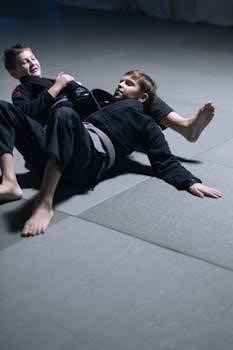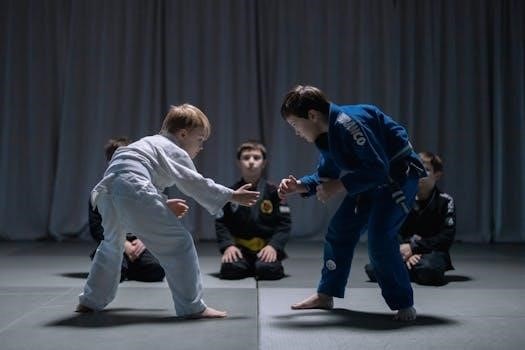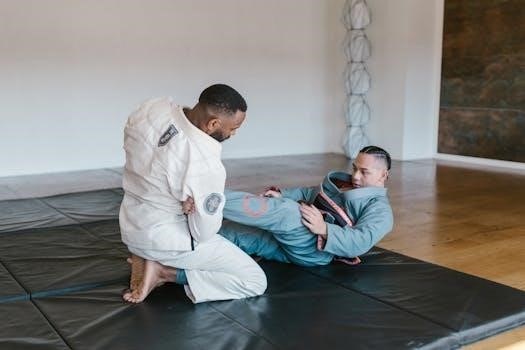Finding the correct BJJ gi size is crucial for comfort and performance. This guide will help you navigate the complexities of gi sizing. Proper fit ensures mobility and prevents discomfort during training. Understanding size charts is essential.
Understanding the Importance of Proper Gi Fit
A properly fitted BJJ gi is essential for both comfort and safety during training and competition. A gi that is too large can restrict movement and create excess fabric that opponents can use to gain an advantage. Conversely‚ a gi that is too small may limit your range of motion and cause discomfort. Correct sizing ensures a full range of movement and avoids restrictions‚ optimizing your performance on the mat. This is especially important for techniques that require flexibility and agility.
Basic BJJ Gi Sizing System
BJJ gi sizes use an “A” system‚ ranging from A0 to A6 for adults. Kids’ sizes typically use M0 to M4 or numerical sizes. Higher numbers indicate larger sizes. Understanding this system is key for a good fit.
Explanation of A-Sizes (A0 to A6)
The A-sizes in BJJ gis denote adult sizing‚ with A0 being the smallest and A6 the largest. These sizes are a general guideline for adult men. Each size corresponds to a range of height and weight. A2 is often considered the average size. These sizes are important to understand before considering brand-specific sizing charts. It is important for every beginner to understand the sizes.
Kids Gi Sizing (M0-M4‚ 000-1 etc.)
Kids’ BJJ gi sizing uses a different system than adult sizes. Typically‚ sizes range from M0 to M4‚ with M0 being the smallest. Some brands use numerical sizes like 000‚ 00‚ 0‚ and 1. These sizes accommodate the various heights and weights of children. It’s important to consult brand-specific size charts to ensure the correct fit. Proper fit ensures safety and comfort for young practitioners.

Key Measurements for BJJ Gi Fit
Accurate measurements are vital for finding the right BJJ gi. Key measurements include height‚ weight‚ chest‚ and arm length. Lower body measurements such as waist and inseam are also important for proper fit.
Height and Weight Considerations
Height and weight are the primary factors in determining your initial BJJ gi size. Manufacturers use these measurements as a starting point. It’s best to measure your height first thing in the morning to get a true reading. Similarly‚ weigh yourself before eating for consistent results. These basic metrics are the foundation for finding a gi that fits your frame‚ but it is not the only criteria to take into consideration.
Chest‚ Shoulder‚ and Arm Measurements
Accurate chest measurements are crucial for a proper gi fit. Wrap the measuring tape around the widest part of your chest‚ under your armpits‚ keeping it parallel to the floor. Breathe normally for an accurate reading. Shoulder and arm measurements are also key; you will need to measure sleeve length and shoulder width. These upper body measurements ensure the jacket fits comfortably and allows for good movement during training.
Lower Body Measurements (Waist and Inseam)
Proper gi pants fit depends on accurate waist and inseam measurements. Measure your waist circumference at the narrowest point‚ and keep the tape level around your torso. Inseam should be measured from your crotch to your ankle bone or the bottom of your pants. These lower body measurements are key to ensure the pants provide sufficient room for movement and are not too tight or too loose‚ contributing to comfort and performance.
Brand-Specific BJJ Gi Size Charts
Each BJJ gi brand has unique sizing charts. Always check the specific brand’s chart before buying‚ as sizes can vary considerably. This ensures a proper fit according to the manufacturer’s standards.
Importance of Checking Individual Brand Charts
It’s crucial to consult each brand’s specific size chart because sizing varies significantly between manufacturers. A size A2 in one brand may not fit the same as an A2 in another. Brands have different cuts‚ materials‚ and shrinkage rates‚ making brand-specific charts essential for finding the best fit. Not doing so will lead to errors and a costly mistake. Always consult these charts before buying.
Examples of Different Brand Sizing (Venum‚ Tatami‚ Kingz‚ Elite Sports)
Venum gis are known to run large‚ so consider sizing down. Tatami gis usually have a more fitted‚ European cut. Kingz offers standard sizes with ‘L’ and ‘H’ variations for long and heavy builds respectively. Elite Sports has consistent sizing‚ often with pre-shrunk fabric for minimal change post-wash. Each brand’s sizing varies‚ so always check the specific chart. These differences highlight why using brand-specific charts is crucial.
Special BJJ Gi Designations
BJJ gis use letters like ‘L’ for long‚ ‘H’ for heavy‚ and ‘F’ for female cuts. These designations help accommodate various body types. Understanding these helps ensure a better fit for specific needs. They are essential.
Understanding L (Long)‚ H (Heavy)‚ and F (Female) Designations
The ‘L’ designation on a BJJ gi indicates a longer cut in the arms and legs‚ ideal for taller individuals. The ‘H’ signifies a wider cut‚ designed for those with a stockier or more muscular build. The ‘F’ is for female-specific cuts‚ offering a more tapered waist and shorter sleeves. These designations are crucial for finding a gi that fits your unique body type and ensures optimal comfort and mobility on the mat. Each helps provide a better fit beyond standard sizes.
Shrinkage and Material Considerations
Gi material significantly impacts shrinkage. Different fabrics shrink differently. Understanding this is crucial for proper gi sizing. Washing and drying methods affect shrinkage rates. Always consider shrinkage when choosing a gi.
How Different Materials Shrink
BJJ gis are made from various materials‚ each with unique shrinkage properties. Cotton gis‚ especially those not pre-shrunk‚ tend to shrink more significantly than hemp or blended fabrics. The weave of the material also plays a role‚ with tighter weaves generally experiencing less shrinkage; It’s crucial to check the manufacturer’s specifications regarding material composition and pre-shrinking before making a purchase. Expect some shrinkage and plan accordingly.
Washing and Drying Tips to Minimize Shrinkage
To minimize shrinkage of your BJJ gi‚ always wash it in cold water. Hot water causes fibers to contract‚ leading to significant shrinkage. Avoid using a machine dryer‚ which applies high heat and dramatically increases shrinkage. Instead‚ hang your gi to air dry‚ preferably away from direct sunlight. This method preserves the original size and shape of your gi and prolongs its lifespan.
Body Type and BJJ Gi Fit
Body type significantly impacts gi fit. Athletic‚ stocky‚ and tall/lean builds require different considerations. Understanding your body type helps in selecting the right size and cut for optimal comfort and performance during BJJ training.
Sizing Considerations for Athletic Builds
Athletic builds‚ often characterized by broader shoulders and a narrower waist‚ can find standard gi cuts challenging. The key is to ensure the gi fits comfortably across the shoulders and chest without being too baggy around the waist. Look for gis with an athletic or tapered cut‚ which allows for a snug fit that doesn’t restrict movement or leave excess fabric. It may be necessary to consider brands that have specific cuts for an athletic frame.
Sizing Considerations for Stockier Builds
Stockier builds often require gis with more room in the chest‚ shoulders‚ and thighs. Standard sizes can feel too restrictive‚ leading to discomfort and limited movement. Look for gis with a “Heavy” (H) designation or those specifically designed for a broader frame. These gis provide extra room without being excessively long. Consider brands that offer a more generous cut to ensure comfort and mobility. Proper measurement is essential to avoid a gi that feels too tight.
Sizing Considerations for Tall and Lean Builds
Tall and lean builds often face the challenge of finding gis with adequate length without being too wide. Standard sizes may result in sleeves and pants that are too short. Look for gis with a “Long” (L) designation to ensure proper length in arms and legs. Brands offering slim-fit options can provide a more tailored fit. Consider a size up if the length is perfect but the width is too tight. Check specific brand size charts for guidance to avoid a baggy or ill-fitting gi.

Competition Gi Sizing
Competition gi sizing is crucial‚ as even minor discrepancies can lead to disqualification. The IBJJF has strict rules regarding gi measurements. Ensuring compliance is essential for competing. Always double-check specific guidelines before an event.
IBJJF Gi Measurement Guidelines
The International Brazilian Jiu-Jitsu Federation (IBJJF) sets strict guidelines for gi measurements to ensure fairness in competition. These rules cover gi length‚ sleeve length‚ and pant length. Competitors must have gis that adhere to these specific measurements to avoid disqualification. It’s essential to understand these rules before purchasing a competition gi. Always check the latest IBJJF rules for the most up-to-date information. Ensure your gi meets these standards before competing.
Ensuring Gi Compliance for Competition
To ensure your gi is compliant for competition‚ verify it meets IBJJF standards. Measure your gi carefully‚ checking sleeve length‚ jacket length‚ and pant length. Ensure your gi color is also within IBJJF specifications. Wash your gi multiple times before a competition to account for shrinkage. Double-check measurements after the final wash. Having a backup gi that meets regulations is a smart idea. Always adhere to the current IBJJF rules to avoid disqualification.

Frequently Asked Questions (FAQs)
This section addresses common queries about BJJ gi sizing. We’ll explore topics like choosing between sizes‚ shrinkage rates‚ and the differences between A‚ H‚ and L designations. These answers will help you find the perfect fit.
How to Choose Between Two Sizes
If you find yourself between two sizes‚ consider your training goals. For a tighter‚ competition-focused fit‚ choose the smaller size‚ mindful of potential shrinkage. For more comfortable‚ everyday training‚ the larger size may be preferable. Always prioritize comfort and mobility. Check the brand’s specific sizing chart for guidance‚ as variations exist. If unsure‚ seek advice from a knowledgeable source.
Understanding Shrinkage Rates
Shrinkage is a key factor in BJJ gi sizing. Different materials shrink differently; cotton gis typically shrink more than those with synthetic blends; Expect some shrinkage‚ especially after the first few washes. Always wash your gi in cold water and hang dry to minimize shrinkage. Pre-shrunk gis reduce this issue‚ but some shrinkage is still possible. Check the manufacturer’s guidelines to anticipate shrinkage rates accurately.
Differences Between A‚ H‚ and L Sizes
Understanding the differences between A‚ H‚ and L sizes is crucial for proper gi fit. ‘A’ sizes are standard adult cuts‚ fitting most average body types. ‘H’ designates a “heavy” or “husky” cut‚ offering more room in the chest and torso for broader builds. ‘L’ stands for “long”‚ adding length to the sleeves and pants for taller individuals. Knowing these designations helps you select a gi that matches your specific body type and proportions.
Gi Fitting Tips and Alterations
A well-fitting gi allows for free movement and should not be too tight or too loose. Minor alterations are sometimes needed. Acceptable modifications include hemming pants and sleeves for a better fit.
How to Know if a Gi Fits Properly
A properly fitting gi should allow a full range of motion without being restrictive. The sleeves should reach your wrists‚ and the pants should cover your ankles. The jacket should close comfortably without excessive overlap. Ensure that there is enough room to move but not so much that the gi feels baggy. Check that the gi’s fabric doesn’t impede your movement during training.
Acceptable Gi Alterations
Minor alterations are sometimes necessary for a perfect gi fit. Hemming the pants or sleeves is generally acceptable‚ as long as it doesn’t drastically change the gi’s original proportions. You can also take in the jacket slightly for a more tailored fit. However‚ avoid adding patches or designs that aren’t approved‚ especially for competition. Always make alterations carefully and professionally to maintain the gi’s integrity.

International Gi Sizing Comparisons
Gi sizes can vary significantly between countries. European brands often have a more fitted cut compared to American brands. Always check specific size charts to avoid errors; Variations are due to differences in body types and preferences.
Differences in Gi Sizes Across Different Countries
International gi sizing varies considerably‚ with European brands often featuring a more tailored‚ fitted cut compared to American brands that typically offer a looser fit. These differences stem from regional body types and preferences‚ making it crucial to consult specific size charts. Some brands‚ particularly those from Asia‚ might also have unique sizing scales‚ so it’s essential to consider these factors when purchasing a gi from a different country to avoid sizing issues.
on Finding Your Perfect Gi Fit
Accurate measurements‚ consideration of your training goals‚ and understanding shrinkage are key. Select the right size‚ and ensure a comfortable‚ competition-ready fit. Remember to check brand-specific size charts for best results.
To achieve an accurate gi size‚ start with precise height and weight measurements‚ taken in the morning for consistency. Then‚ measure your chest‚ shoulder‚ arms‚ waist‚ and inseam‚ ensuring the tape is snug but not tight. Always double-check your measurements for accuracy. Consider your body type and training goals‚ and finally‚ check each brand’s specific size chart to ensure a perfect fit. Remember‚ a well-fitting gi enhances both comfort and performance.
